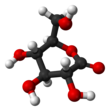Glucono-δ-lactone(GDL), also known as gluconolactone, is an organic compound with the formula(HOCH)3(HOCH2CH)CO2.A colorless solid, it is an oxidized derivative ofglucose.
| |||
| Names | |||
|---|---|---|---|
| IUPAC name
D-Glucono-1,5-lactone
| |||
| Systematic IUPAC name
(3R,4S,5S,6R)-3,4,5-Trihydroxy-6-(hydroxymethyl)oxan-2-one[2] | |||
| Identifiers | |||
3D model (JSmol)
|
|||
| ChEBI | |||
| ChEMBL | |||
| ChemSpider | |||
| DrugBank | |||
| ECHA InfoCard | 100.001.833 | ||
| EC Number |
| ||
| E number | E575(acidity regulators,...) | ||
| KEGG | |||
PubChemCID
|
|||
| UNII | |||
CompTox Dashboard(EPA)
|
|||
| |||
| |||
| Properties | |||
| C6H10O6 | |||
| Molar mass | 178.140g·mol−1 | ||
| Melting point | 150–153 °C (302–307 °F; 423–426 K) | ||
Except where otherwise noted, data are given for materials in theirstandard state(at 25 °C [77 °F], 100 kPa).
| |||
It is typically produced by the aerobic oxidation of glucose in the presence of the enzymeglucose oxidase.The conversion cogenerateshydrogen peroxide,which is often the key product of the enzyme:
- C6H12O6+ O2→ C6H10O6+ H2O2
Gluconolactone spontaneously hydrolyzes togluconic acid:[4]
- C6H10O6+ H2O → C6H12O7
Applications
editGluconolactone is afood additivewith theE-numberE575[5]used as asequestrant,anacidifier,[6]or acuring,pickling,orleavening agent.It is alactoneofD-gluconic acid.Pure GDL is a white odorlesscrystallinepowder.
GDL has been marketed for use infeta cheese.[7]GDL is pH-neutral, but hydrolyses in water to gluconic acid which is acidic, adding a tangy taste to foods, though it has roughly a third of thesournessofcitric acid.It is metabolized to6-phospho-D-gluconate;one gram of GDL yields roughly the same amount ofmetabolicenergy as one gram ofsugar.
Upon addition to water, GDL is partiallyhydrolysedto gluconic acid, with the balance between the lactone form and the acid form established as achemical equilibrium.The rate of hydrolysis of GDL is increased by heat and highpH.[8]
The yeastMaudiozyma bulderican be used to ferment gluconolactone to ethanol and carbon dioxide. The pH value greatly affects culture growth. Gluconolactone at 1 or 2% in a mineral media solution causes the pH to drop below 3.[9]
It is also a complete inhibitor of the enzymeamygdalin beta-glucosidaseat concentrations of 1 mM.[10]
See also
editReferences
edit- ^Budavari, Susan, ed. (2001),The Merck Index: An Encyclopedia of Chemicals, Drugs, and Biologicals(13th ed.), Merck,ISBN0911910131,4469.
- ^abPubChem."D-Gluconic acid, delta-lactone".pubchem.ncbi.nlm.nih.gov.Archivedfrom the original on 2022-02-25.Retrieved2022-05-03.
- ^Beil.18,V, 5, 11
- ^Wong, Chun Ming; Wong, Kwun Hei; Chen, Xiao Dong (2008). "Glucose oxidase: Natural Occurrence, Function, Properties and Industrial Applications".Applied Microbiology and Biotechnology.78(6): 927–938.doi:10.1007/s00253-008-1407-4.PMID18330562.S2CID2246466.
- ^"Current EU approved additives and their E Numbers".Food Standards Agency.Archived fromthe originalon 22 April 2022.
- ^Martin, F.; Cayot, N.; Marin, A.; et al. (2009)."Effect of oxidoreduction potential and of gas bubbling on rheological properties and microstructure of acid skim milk gels acidified with glucono-δ-lactone"(PDF).Journal of Dairy Science.92(12): 5898–5906.doi:10.3168/jds.2009-2491.PMID19923593.Archived(PDF)from the original on 2020-03-11.Retrieved2019-08-16.
- ^Blythman, Joanna (21 February 2015)."Inside the food industry: the surprising truth about what you eat".The Guardian.Archived from the original on 13 August 2016.Retrieved28 October2016.
{{cite web}}:CS1 maint: bot: original URL status unknown (link) - ^Pocker, Y.; Green, Edmond (1973). "Hydrolysis of D-Glucono-δ-lactone. I. General Acid–Base Catalysis, Solvent Deuterium Isotope Effects, and Transition State Characterization".J. Am. Chem. Soc.95(1): 113–19.doi:10.1021/ja00782a019.PMID4682891.
- ^Van Dijken, J. P.; Van Tuijl, A.; Luttik, M. A.; Middelhoven, W. J.; Pronk, J. T. (2002)."Novel pathway for alcoholic fermentation of delta-gluconolactone in the yeast Saccharomyces bulderi".Journal of Bacteriology.184(3): 672–678.doi:10.1128/JB.184.3.672-678.2002.PMC139522.PMID11790736.
- ^Petruccioli, M.; Brimer, L.; Cicalini, A. R.; Federici, F. (1999)."Production and Properties of the Linamarase and Amygdalase Activities of Penicillium aurantiogriseum P35".Bioscience, Biotechnology, and Biochemistry.63(5): 805–812.doi:10.1271/bbb.63.805.PMID10380623.

